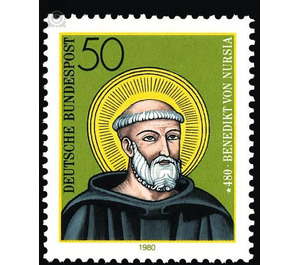1500th birthday of St. Benedict of Nursia - Germany / Federal Republic of Germany 1980 - 50 Pfennig
Theme: Calender
| Country | Germany / Federal Republic of Germany |
| Issue Date | 1980 |
| Face Value | 50.00 |
| Color | multi-colored green |
| Perforation | K 13:13 1/4 |
| Printing Type | Six-color offset printing |
| Stamp Type | Postage stamp |
| Item Type | Stamp |
| Chronological Issue Number | 942 |
| Chronological Chapter | GER-BRD |
| Michel ID | BRD 1055 |
| SID | 575887 |
| In 65 Wishlists | |
In 1980, the birthday of St. Benedict of Nursia for the 1,500th anniversary. Times. According to tradition, Benedict was born in 480 to Nursia, now Norcia in the Umbrian province of Perugia, the son of wealthy parents. Under the impression of political, economic, cultural and moral decline, which marked this time of tremendous upheaval, migration and the irretrievable decay of the Western Roman Empire, he broke off his studies in Rome, temporarily joined an ascetic community, and then spent three for him decisive years as a hermit in a cave of the Aniotal at Subiaco. In the nearby mountains he took over the leadership of a hermit community, but soon returned to Subiaco back and founded there twelve smaller monasteries. Already nearly fifty years old, Benedict moved to Monte Cassino with the monks around 529, where he built a large monastery for many monks, to whom he presided as abbot, and wrote down his monastic rule, the Benedictine Rule. Thanks to the charisma and the fascinating personality of St. Benedict, whose life Pope Gregory I has vividly told, this monastery has been very attractive from the beginning. It became a center of religious and spiritual life and the cradle of a widely ramified order. While the Greco-Roman culture was ousted in public, its spiritual goods could be saved by the monasteries with their offices, libraries and schools and transmitted to later generations. With the rule he wrote, Benedict created a stable basis for a monastic living together and for a monastic order, which has meanwhile spread beyond the borders of old Europe and took on new responsibilities among the young peoples of America and Africa and the high cultures of Asia Has. Saint Benedict died in 547 in Monte Cassino. On the occasion of the consecration of the after the destruction in World War II rebuilt monastery declared him Pope Paul VI. on October 24, 1964 Patron of Europe. (Text: Commissariat of German Bishops, Catholic Office Bonn)
| Condition | Name | In Stock | Price | Price + Shipping | Store | |
|---|---|---|---|---|---|---|
 | Unmounted Mint ** | 1500th birthday of St. Benedict of Nursia - Germany / Federal Republic of Germany 1980 - 50 Pfennig | 10 | US $0.427 | US $3.62 |  FILATELIELOKET (0) FILATELIELOKET (0)Shipping US $3.19 Minimum Order US $2.67 |


